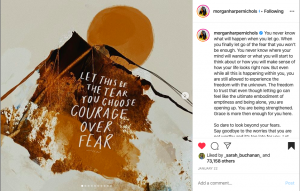In recent years, poetry has taken on a new shape, one that reaches us where we find ourselves the most: social media. Modern poets coined with the name “Instapoets” have taken their work online, publishing their poems via social media posts and creating experiences that allow visual art to coexist with poetic writing.
Taking this approach to poetry writing has revolutionized the way we perceive and digest the art form. For decades, students have shuddered at the word poetry. In fact, for many, poetry is equivalent to tedium, bringing back memories of long hours analyzing abstract, flowery language and trying to extract some sense of meaning from it. We’ve suffered through Shakespeare’s sonnets, struggled with the jargon in Poe’s poetic narratives, and memorized Frost’s famous lines: “Two roads diverged in a wood, and I—/ I took the one less traveled by, / And that has made all the difference.”
Throughout history, poetry has been a difficult art form to digest, especially in its early stages starting in the eighth century BCE when literacy rates were low and poetry writing was reserved for the educated, higher classes. Despite this challenge, we’ve seen poetry exist in a variety of sensory experiences that allow people of all backgrounds to enjoy and understand it. Homer’s famous epic The Odyssey was shared through oral tradition before it was transcribed, revealing how poets have made great strides even thousands of years ago to make their work accessible to the lower classes. In the sixties and seventies, we saw poetry meet music with songwriters like Bob Dylan, a world-renowned musician and Nobel Prize winner for literature. We all know the words to his famous tune “Blowin’ in the Wind,” his poetic lyrics made more digestible by the song’s simple melody.
While literacy rates are now much higher, we still regard poetry as a higher form of art, a puzzle for intellectuals to solve. Because of this, it’s still taught in schools, often by force-feeding rhyme schemes and iambic pentameter to disengaged students, making the genre even less appealing to our generation.
What sets Instapoets apart from the poets we’ve read in our high school English classes is their willingness to meet their readers where they’re at in a less pretentious way. They set aside the hefty, over-sophisticated language of traditional poetry and lay out their emotions plainly, allowing their words to be easily consumed by readers as they delve into feelings relevant to the people living in the world today.

https://www.instagram.com/atticuspoetry/?hl=en
Duncan Penn, or, as he’s known on social media, Atticus, does just that. With nearly 1.5 million followers on Instagram, his profile is a collage of black and white images containing the verses of his poems, some scribbled on paper and others tattooed across people’s bodies. He writes for our generation, the young adults navigating love and heartbreak and those trying to survive in a world where sharing authentic feelings comes with harsh consequences. On the shoulder blade of an anonymous woman are the lines “The hardest step / we all must take / is to blindly trust / in who we are.” It’s a testament to how deeply connected our generation is to the simple yet profound words of Atticus.

https://www.instagram.com/morganharpernichols/?hl=en
In addition to making poetry more accessible through simplifying the art form, Instapoets have also made their works a multi-sensory experience so that their readers can experience the work in more than one dimension. Morgan Harper Nichols, a poet, digital artist, and songwriter, has recently grown popular in the online poetry scene, producing affirmations through poetry set to designs she creates digitally. What started as a small social media account in which Nicholas would write brief poems of encouragement in response to emails has blown up into a 1.2 million following. Despite her newfound fame, Nichols continues to maintain her personal touch, frequently offering to write short, personalized poems for her followers for free. Nichols also has a podcast where she occasionally reads her poems aloud, or even pairs her work to music. What set Nichols apart from any poets we’ve seen before is her inclusivity and passion for inviting new artists into the world of online poetry. Nichols will occasionally post tutorial videos on her Instagram or YouTube channel that walk viewers through her process of writing the poems and designing backgrounds for them.

https://www.instagram.com/rupikaur_/?hl=en
Merging poetry with social media has revolutionized the art form by reaching a greater audience, but the transition to digitalized poetry has also benefitted Instapoets by giving them a platform to build and expand their careers. Rupi Kaur, an Instapoet who started sharing her work on Tumblr, has used her success on social media to become a New York Times best-selling author. Kaur started sharing her work online in 2012, thinking that her poetry could never earn her enough money to sustain herself. Just two years later, her first poetry collection, Milk and Honey, hit the shelves, becoming an instant hit among a large demographic of readers that range from college students looking for words of comfort to academics keeping up with the genre.
The success of Milk and Honey proved that online poetry is not just an art form, it’s an industry. Witnessing success stories like Kaur’s has inspired other writers to pick up their pens and share their work online in the hopes of gaining the same kind of recognition.

https://www.instagram.com/nikita_gill/?hl=en
Nikita Gill, an Instapoet out of Belfast, was able to resurrect a dying dream through online poetry. After having her work rejected for publication 137 times, Gill took her poetry to Instagram where she built a significant following. Now, she has five published poetry collections. Gaining recognition on social media has also allowed Gill to pursue other dreams, as she’s been able to publish short stories and work on novels with the financial cushion from her poetry collections.
Like any industry in the arts, however, only a few lucky artists will make it to the top. But the immense impact online poetry has had on poetry writing should not be overlooked. The success stories we’ve seen out of Instapoetry has encouraged other writers to share their work and continue writing, giving them an accessible platform to publicize their ideas. People are no longer counting syllables and compensating word choice for rhyme scheme; they’re simply writing and allowing form to follow their ideas. Instapoetry may provide a door for the poets who have good ideas but just don’t know where to start, and it may be the key to making poetry a less intimidating genre, but rather something that can be consumed and enjoyed by everyone.

